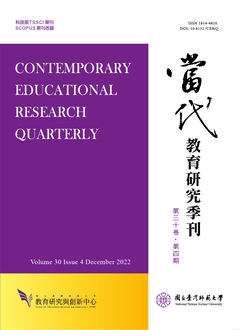

本研究旨在探究幼兒對於無字圖畫書中圖像元素的觀察及解讀。鑑於在圖像、影像充斥的科技世代,國內仍將識讀(literacy)的重點著重於文字的閱讀及書寫,鮮少以幼兒對圖像元素之閱讀反應做為探究圖畫書的研究議題,研究者選定三本無字圖畫書-《狼來了》、Rainstorm,以及The Grey Lady and the Strawberry Snatcher做為共讀書籍,並以八名幼稚園大班幼兒為研究對象,與幼兒進行圖畫書故事述說、半結構式訪談以及讀後繪畫作品創作及討論,試圖探究幼兒如何觀察、解讀無字圖畫書之圖像元素以建構圖像故事之意義。研究發現如下:(1)幼兒對於圖畫書封面觀察細微,但忽略其他近文本設計內容;(2)幼兒對於顏色、線條、形狀等多項圖像元素觀察豐富,且在讀後作品中重現個人對於無字圖畫書內容及構圖的觀察結果;(3)幼兒對於框架、線條、形狀、肢體動作等圖像元素有依循故事情節且元的解讀。研究結果並與國外文獻對照,期能開啟國內對幼兒圖像閱讀研究之對話。
Visual messages are the dominant form of communication today, and the meaning of literacy has been broadened to include the language of images and other modes. Yet, in most early childhood education settings in Taiwan, the emphasis of literacy education is still on the reading and writing of words. This study aimed to fill this gap by investigating how Taiwanese young children observe and interpret images in wordless picture books, and compared the findings to studies done in the West. Eight 6-year-old children read three wordless picture books—Wolf, Rainstorm and The Grey Lady and the Strawberry Snatcher—with the investigator individually. They read the pictures and told the stories in their own words, followed by interviews which asked about their interpretation of the pictorial elements in the books. The children also drew pictures of the things that impressed them the most from the books, and this activity was followed by interviews with the researcher about the drawings. The findings showed that young children’s reading experiences played an important role in how they read the peritextual features of picture books. Young children observed more than ten different kinds of visual elements in the wordless books. Both the stories they told and their drawings showed how they perceived the visual elements and pictorial compositions in the books. Moreover, the children made sense of the wordless books by constructing a coherent plot, and they had diverse interpretations towards certain elements in the books.

本著作係採用創用 CC 姓名標示-非商業性 3.0 台灣 授權條款授權.
本刊國立台灣師範大學教育研究與創新中心
106台北市和平東路一段162號 | 電話: 02-7749-3670 | E-mail: cerecerq@gmail.com
教創中心 | 師大 | 電子報 | 線上投審系統
本刊由國家科學及技術委員會人文社會科學研究中心補助經費
© 2014 CERI-NTNU
